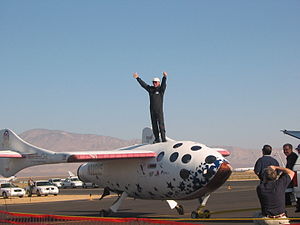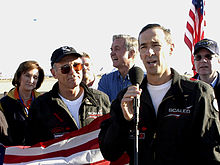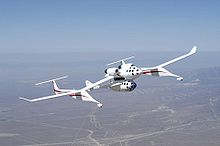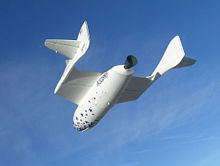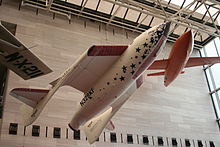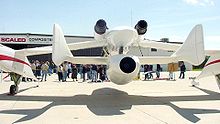- SpaceShipOne
-
"Space Ship One" redirects here. For the album by Paul Gilbert, see Space Ship One (album).
SpaceShipOne Astronaut Mike Melvill after his September 29, 2004 spaceflight. Role Spaceplane Manufacturer Scaled Composites Designer Burt Rutan First flight 20 May 2003 Retired 4 October 2004 Primary user Mojave Aerospace Ventures Number built 1 Developed into SpaceShipTwo Career Preserved at National Air and Space Museum SpaceShipOne was a suborbital air-launched spaceplane that completed the first manned private spaceflight in 2004. That same year, it won the US$10 million Ansari X Prize and was immediately retired from active service. Its mothership was named "White Knight". Both craft were developed and flown by Mojave Aerospace Ventures, which was a joint venture between Paul Allen and Scaled Composites, Burt Rutan's aviation company. Allen provided the funding of approximately US$25 million.
Rutan has indicated that ideas about the project began as early as 1994 and the full-time development cycle time to the 2004 accomplishments was about three years. The vehicle first achieved supersonic flight on December 17, 2003, which was also the one-hundredth anniversary of the Wright Brothers' historic first powered flight. SpaceShipOne's first official spaceflight, known as flight 15P, was piloted by Mike Melvill. A few days before that flight, the Mojave Air and Space Port was licensed as the USA's first commercial spaceport. A few hours after that flight, Melvill became the first licensed U.S. commercial astronaut. The overall project name was "Tier One" which has evolved into Tier 1b with a goal of taking a successor ship's first passengers into space within the next few years.
Contents
Development and winning the X Prize
SpaceShipOne was developed by Mojave Aerospace Ventures (a joint venture between Paul Allen and Scaled Composites, Burt Rutan's aviation company, in their Tier One program), without government funding. On June 21, 2004, it made the first privately funded human spaceflight. On October 4, it won the US$10 million Ansari X Prize, by reaching 100 kilometers in altitude twice in a two-week period with the equivalent of three people on board and with no more than ten percent of the non-fuel weight of the spacecraft replaced between flights. Development costs were estimated to be US$25 million, funded completely by Paul Allen.
During its test programme, SpaceShipOne set a number of important "firsts", including first privately funded aircraft to exceed Mach 2 and Mach 3, first privately funded manned spacecraft to exceed 100km altitude, and first privately funded reusable manned spacecraft.
SpaceShipOne is an experimental air-launched rocket-powered aircraft with suborbital flight capability that uses a hybrid rocket motor. The design features a unique "feathering" atmospheric reentry system where the rear half of the wing and the twin tail booms folded upward along a hinge running the length of the wing; this increased drag while remaining stable. The achievements of SpaceShipOne are more comparable to the X-15 than orbiting spacecraft like the Space Shuttle. Accelerating a spacecraft to orbital speed requires more than 60 times as much energy as accelerating it to Mach 3.[1]
SpaceShipOne is registered with the FAA as N328KF. N is the prefix for US-registered aircraft; 328KF was chosen by Scaled Composites to stand for 328 K (abbreviation for 1000) feet (about 100 kilometers), the officially designated edge of space. The original choice of registry number, N100KM, was already taken. N328KF is registered as a glider, reflecting the fact that most of its independent flight is unpowered.
SpaceShipOne's first flight, 01C, was an unmanned captive flight test on May 20, 2003. Glide tests followed, starting with flight 03G on August 7, 2003. Its first powered flight, flight 11P, was made on December 17, 2003, the 100th anniversary of the first powered flight.
On April 1, 2004, Scaled Composites received the first license for sub-orbital rocket flights to be issued by the US Office of Commercial Space Transportation. This license permitted the company to conduct powered test flights over the course of one year. On June 17, 2004, Mojave Airport reclassified itself (part-time) as the Mojave Spaceport.
Flight 15P on June 21, 2004, was SpaceShipOne's first spaceflight, and the first privately funded human spaceflight. There were a few control issues,[2] but these were resolved prior to the Ansari X PRIZE flights that followed, with flight 17P on October 4, 2004, winning the prize.
The SpaceShipOne Team was awarded the Space Achievement Award[3] by the Space Foundation in 2005.
Flights
All of the flights of SpaceShipOne were from the Mojave Airport Civilian Flight Test Center. Flights were numbered, starting with flight 01 on May 20, 2003. One or two letters are appended to the number to indicate the type of mission. An appended C indicates that the flight was a captive carry, G indicates an unpowered glide, and P indicates a powered flight. If the actual flight differs in category from the intended flight, two letters are appended: the first indicating the intended mission and the second the mission actually performed.
In the table below, the "top speed" reported is the Mach number at burn-out (the end of the rocket burn). This is not an absolute speed.
SpaceShipOne flights Flight Date Top speed Altitude Duration Pilot 01C May 20, 2003 Mach 0.53 14.63 km[4] 1 h 48 min unmanned 02C July 29, 2003 14 km[5] 2 h 06 min Mike Melvill 03G August 7, 2003 278 km/h 14.33 km[4] 19 min 00 s Mike Melvill 04GC August 27, 2003 370 km/h[4] 14 km[5] 1 h 06 min Mike Melvill 05G August 27, 2003 370 km/h 14.69 km[4] 10 min 30 s Mike Melvill 06G September 23, 2003 213 km/h 14.26 km[4] 12 min 15 s Mike Melvill 07G October 17, 2003 241 km/h 14.08 km[4] 17 min 49 s Mike Melvill 08G November 14, 2003 213 km/h 14.42 km[4] 19 min 55 s Peter Siebold 09G November 19, 2003 213 km/h 14.72 km[4] 12 min 25 s Mike Melvill 10G December 4, 2003 213 km/h 14.75 km[4] 13 min 14 s Brian Binnie 11P December 17, 2003 Mach 1.2 20.67 km[4] 18 min 10 s Brian Binnie 12G March 11, 2004 232 km/h 14.78 km[4] 18 min 30 s Peter Siebold 13P April 8, 2004 Mach 1.6 32.00 km[4] 16 min 27 s Peter Siebold 14P May 13, 2004 Mach 2.5 64.43 km[4] 20 min 44 s Mike Melvill 15P June 21, 2004 Mach 2.9 100.124 km[4] 24 min 05 s Mike Melvill 16P September 29, 2004 Mach 2.92 102.93 km[4] 24 min 11 s Mike Melvill 17P October 4, 2004 Mach 3.09 112.014 km[4] 23 min 56 s Brian Binnie The flights were accompanied by two chase planes; an Extra 300 owned and flown by Chuck Coleman, and a Beechcraft Starship.[6]
Astronauts
The SpaceShipOne pilots came from a variety of aerospace backgrounds. Mike Melvill is a test pilot, Brian Binnie is a former Navy pilot, and Doug Shane and Peter Siebold are engineers at Scaled Composites. They qualified to fly SpaceShipOne by training on the Tier One flight simulator and in White Knight and other Scaled Composites aircraft.
Retirement
SpaceShipOne now hangs in the National Air and Space Museum in Washington D.C.
SpaceShipOne's spaceflights were watched by large crowds at Mojave Spaceport. A fourth suborbital flight, Flight 18P, was originally scheduled for October 13, 2004. However, Burt Rutan decided not to risk damage to the historic craft, and cancelled it and all future flights.
On July 25, 2005 SpaceShipOne was taken to the Oshkosh Airshow in Oshkosh, Wisconsin. After the airshow, Mike Melvill and crew flew the White Knight, carrying SpaceShipOne, to Wright-Patterson Air Force Base in Dayton, Ohio, where Melvill spoke to a group of about 300 military and civilian personnel. Later in the evening, Melvill gave a presentation at the Dayton Engineers Club, entitled "Some Experiments in Space Flight", in honor of Wilbur Wright's now-famous presentation to the American Society of Mechanical Engineers in 1901 entitled "Some Experiments in Flight." The White Knight then transported SpaceShipOne to the Smithsonian Institution's National Air and Space Museum to be put on display. It was unveiled on Wednesday October 5, 2005 in the Milestones of Flight gallery and is now on display to the public in the main atrium between the Spirit of St. Louis and the Bell X-1.
SpaceShipOne became a popular model rocket in 2004. Estes Industries currently offers several flying model rockets of SpaceShipOne. A piece of SpaceShipOne's carbon fiber material was launched aboard the New Horizons mission to Pluto in 2006.[7]
Replica
A year after its appearance in the Oshkosh Airventure airshow, the Experimental Aircraft Association featured a full-scale replica of the spacecraft in a wing of its museum which housed other creations of Burt Rutan. Using the same fiberglass molds as the original, it was so exact in its replication - despite not having any doors or interior - that it was dubbed "Serial 2 Scaled" by Scaled Composites. Each and every painstaking detail in its appearance was matched, down to the N328KF registration number on its fuselage. It is so precise that, during a video presentation held every hour in the museum, it can display the two different modes of its 'feathering' ability, albeit through the aid of pulleys and wires (there is no machinery in the replica).[8]
Another full-scale replica of SpaceShipOne hangs in the rotunda of the William Thomas Terminal at Meadows Field Airport in Bakersfield and a third is on display in the Mojave Spaceport's Legacy Park alongside the original Roton Atmospheric Test Vehicle.[citation needed]
Subsequent spacecraft
With the success of Tier One meeting its project goals, a successor project started in 2004 was Tier 1b. The successor ship names SpaceShipTwo and White Knight Two. The name of the joint venture between Virgin Group and Scaled Composites is called The Spaceship Company, with a goal of carrying passengers under the name Virgin Galactic spaceliner with an initial target of a commercial fleet of five spacecraft.[9][10]
In August 2005, Virgin Galactic stated that if the upcoming suborbital service with SpaceShipTwo is successful, the follow-up will be known as SpaceShipThree.[11][12]
Specifications
Data from astronautix.com[5]
General characteristics
- Crew: one, pilot
- Capacity: 2 passengers
- Length: 28 ft (8.53 m) ()
- Wingspan: 16 ft 5 in (8.05 m)
- Height: ()
- Wing area: 161.4 ft² (15 m²)
- Empty weight: 2,640 lb (1,200 kg)
- Loaded weight: 7,920 lb (3,600 kg)
- Powerplant: 1 × N2O/HTPB SpaceDev Hybrid rocket motor, 7,500 kgf (74 kN)
- Isp: 250 s (2450 Ns/kg)
- Burn time: 87 seconds
- Aspect Ratio: 1.6
Performance
- Maximum speed: Mach 3.09 (2,170 mph, 3,518 km/h)
- Range: 35 nm (40 mi, 65 km)
- Service ceiling: 367,360 ft (112,000 m)
- Rate of climb: 82,000 ft/min (416.6 m/s)
- Wing loading: 49.07 lb/ft² (240 kg/m²)
- Thrust/weight: 2.08
Gallery
-
Hybrid rocket engine detail of SpaceShipOne (more information).
-
SpaceShipOne landing after its June 21, 2004 space flight (Flight 15P)
-
SpaceShipOne in the National Air and Space Museum in Washington D.C. with the Spirit of Saint Louis and Bell X-1 "Glamorous Glennis"
See also
- List of spaceflights (2004)
- Mojave Magic: A Turtle's Eye View of SpaceShipOne
- X-15
References
- ^ Elon Musk Is Betting His Fortune on a Mission Beyond Earth's Orbit
- ^ Brekke, Dan (7 July 2004). "SpaceShipOne Back on Course". Wired. http://www.wired.com/science/space/news/2004/07/64123. Retrieved 7 February 2011.
- ^ http://www.nationalspacesymposium.org/symposium-awards
- ^ a b c d e f g h i j k l m n o p "SpaceShipOne Flight Tests". Scaled Composites. http://www.scaled.com/projects/tierone/combined_white_knight_spaceshipone_flight_tests.
- ^ a b c "SpaceShipOne". Encyclopedia Astronautica. http://www.astronautix.com/craft/spaipone.htm.
- ^ Jefferson, Catherine (2004). "First Private Manned Space Flight". http://www.devsite.org/lab/spaceshipone/data.shtml.
- ^ "Pluto Mission to Carry Piece of SpaceShipOne". Space.com. December 20, 2005. http://www.space.com/astronotes/astronotes.html.
- ^ Jeff Hecht (29 July 2005). "SpaceShipOne". New Scientist. Archived from the original on 2008-05-02. http://web.archive.org/web/20080502133833/http://www.airventuremuseum.org/collection/aircraft/SpaceShipOne.asp. Retrieved 2008-06-21.
- ^ Leonard David. "Virgin Galactic Spaceliner Steps Forward". Space News. http://www.space.com/spacenews/businessmonday_070226.html. Retrieved 2007-04-06.[dead link]
- ^ "Space tourism company to fly in 2008". AirVenture Museum. http://space.newscientist.com/article/dn7747. Retrieved 2007-04-06.
- ^ "SpaceShipThree poised to follow if SS2 succeeds". Flight International. 23 August 2005. http://www.flightglobal.com/Articles/2005/08/23/Navigation/200/201097/SpaceShipThree+poised+to+follow+if+SS2+succeeds.html. Retrieved 2007-04-06.
- ^ jnhtx (87543) (July 30, 2006). "Notes on Rutan presentations at EAA Oshkosh". Slashdot. http://science.slashdot.org/comments.pl?sid=157540&threshold=1&commentsort=5&tid=160&mode=nested&cid=13205378. Retrieved 2007-04-06.
- SpaceShipOne: an illustrated history by Dan Linehan, Foreword by Arthur Charles Clarke (2008) ISBN 076033188X
External links
The Spaceship Company Companies 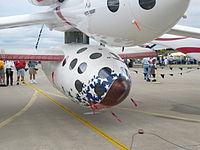
People Ships SpaceShipOne · White Knight · SpaceShipTwo · (Enterprise · Voyager) · White Knight Two · (Eve) · SpaceShipThree
Sequence Places See also Scaled Composites Main designs VariEze • Long-EZ • Boomerang • Pond Racer • Proteus • SpaceShipOne • SpaceShipTwo • White Knight • White Knight Two • Tier One • Tier 1b • Tier Two
Technology demonstrators Unmanned vehicles As subcontrator Space tourism Companies Armadillo Aerospace · Bigelow Aerospace · Blue Origin · EADS Astrium · Mojave Aerospace Ventures · Orbital Sciences Corporation · RocketShip Tours · Scaled Composites · Space Adventures · SpaceX · Virgin Galactic · XCOR Aerospace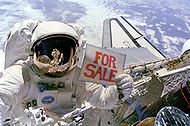
Organizations Successful spacecraft Living in space Space competitions Categories:- Manned spacecraft
- Individual aircraft
- Parasite aircraft
- Private spaceflight
- Reusable space launch systems
- Rocket-powered aircraft
- Tier One
- United States experimental aircraft 2000–2009
- Individual aircraft in the collection of the Smithsonian Institution
- Individual spacecraft in the collection of the Smithsonian Institution
Wikimedia Foundation. 2010.

